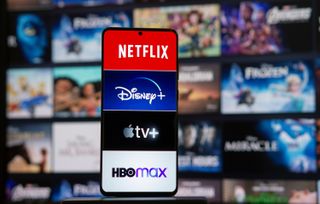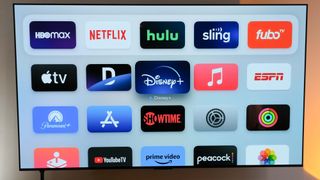Cutting the cord was supposed to be our cheap future — then came the price hikes
Yes, it feels like streaming services are getting worse

Another week, another price hike or two. Originally, the best streaming services and best cable TV alternatives felt better than this. We cut the cord to get away from cable and its titanic bills.
Now, the burden continues to increase on the customers, all the while we hear that actors and writers make pittances from shows and movies on streaming compared to the studios and services. Mandy Moore, for example, said she only got pennies for This Is Us.
So, what the heck is going on? Most recently, we saw Peacock raise its monthly bill by $1 ($5 to $6) and YouTube Premium go up by $2 ($12 to $14). Except if you're a long-time YouTube Premium subscriber, and you're seeing a price increase of as much as $4 per month — as I am.
Don't get me wrong, I'm not un-cutting the cord, but it's a good a time as any to look at the streaming landscape to re-examine how we got here.
Lots of price hikes add up

Looking back at the price changes over the last five years, you can see increases of up to 82% from the likes of YouTube TV, but also 60% from Sling and 41% from Netflix. And all but three of the below services have avoided raising rates faster than the 21.5% rate of inflation from 2018 to 2023.
| Service | 2018 price | 2023 price | Increase percentage |
|---|---|---|---|
| YouTube TV | $40 | $73 | 82% |
| Sling TV (Blue or Orange) | $25 | $40 | 60% |
| Netflix (standard, 1080p) | $11 | $15.49 | 41% |
| Hulu (ad-supported) | $8 | $8 | n/a |
| Max (formerly HBO) | $15 | $16 | 7% |
| YouTube Premium | $10 | $14 | 40% |
| Disney Plus (ad-free) | $7 (2019 launch price) | $11 | 57% |
| ESPN Plus | $5 | $10 | 100% |
| Peacock (Premium) | $5 | $6 | 20% |
| Apple TV Plus | $5 (2019 launch price) | $7 | 40% |
Most of those services have only raised prices by small increments at a time, in order to avoid sticker shock. Sometimes it's by $1 (Peacock) or $2 (Apple TV Plus).
But then there's Sling TV, a titan among the cord-cutter options, which gave me two price-hikes in the last year or so. The first $5 increase had no new perk to explain the price, and the second $5 bump happened because I was in a market getting ABC — and I couldn't opt out of that because I had Sling Blue. I got Sling because I wanted the most-affordable option, and because I didn't need ABC (I use Hulu for Abbott Elementary, anyway).
That was the rare exception to how Sling is more user-customizable than other services. For example, don't get me started on how Fubo's started charging people at least $11 per month for regional sports networks, even if you don't want them.
Other times, they pull a weird trick by keeping the price the same but taking away features, like how Disney Plus kept its $8 price, if you were OK with ads. Or how HBO Max kept its $16 price when it became Max, but moved 4K plus Dolby Vision and Atmos into a new $20 tier.
My best advice with all of this is, unfortunately, a lot like homework. I have a spreadsheet I check monthly, if not more frequently. Every time I do, I think "are these services giving me enough bang for my buck?"
Looking up prices, making a spreadsheet and setting reminders to audit your purchases may sound like work, but it's a free and private option. That's more than I can say for services such as Rocket Money, which charges between $3 (annual) to $12 (monthly) per month to audit your purchases for you.
Why is this happening?

Remember when Disney Plus first arrived, with the promise of the whole Disney library for just $7.99 per month? It seemed unreal, right? Well we now know why our gut instincts were right: Disney Plus has never been profitable, a common financial situation among streaming services that's recently come under fire on Wall Street.
So, the streaming services took every option they could, starting by shaking all the money out of the customers that can be done. Most visibly, that comes with the above price increases. Then, there's the rise of ad-supported paid streaming services, as we saw Netflix and Max (then HBO Max) find other people (advertisers) to pay them. Oh, and then there's the Netflix password-sharing crackdown, which seems to have paid off.
Not to mention the "cost-cutting" tactics of dumping content to make money on free ad-supported services, canceling movies and not paying writers and actors a fair wage.
In short, either these services are too cheap for what they cost, or the books aren't being balanced well enough. Probably both.
Outlook: We need to churn, if only to prove a point
Did you ever learn about a word only to find out you already knew about it? The concept of 'churn' is probably familiar to many beyond the industry insiders who pepper it into their presentations. Right now, it's hard to afford all of the streaming services you want, and so you will probably cancel some and come back later.
For example those who weren't dying to watch Secret Invasion on Disney Plus were probably waiting for next week when the whole series will be available. Unless the lack of word of mouth has already killed that impulse. Then, there's some who don't like Netflix's split-season release model, and are waiting for The Witcher season 3 to all be out at the end of this month.
The execs responsible for all of these decisions hate churn, as it makes their income less reliable. But right now, it's the best way to send a message that the string of price hikes is untenable for the customer.
YouTube TV's significant price increase over the last 5 years didn't come without some improvements, it only boasted "over 50 networks" in 2018, and now packs over 100. But do we need these services to grow to that size? Wouldn't a cheaper YouTube TV (hi, Sling) be better? Maybe YouTube TV could introduce a 'lite' tier so we can find out for ourselves.
More from Tom's Guide
Sign up to get the BEST of Tom's Guide direct to your inbox.
Get instant access to breaking news, the hottest reviews, great deals and helpful tips.

Henry is a managing editor at Tom’s Guide covering streaming media, laptops and all things Apple, reviewing devices and services for the past seven years. Prior to joining Tom's Guide, he reviewed software and hardware for TechRadar Pro, and interviewed artists for Patek Philippe International Magazine. He's also covered the wild world of professional wrestling for Cageside Seats, interviewing athletes and other industry veterans.
-
Tanquen All we can do is cancel when they raise the price. I did the day that YouTube sent me the notice that they were increasing the price. Even when you pay for the commercial free then all the videos you watch have commercials in bedded in them anyway.Reply
I also canceled Netflix and Apple TV. It's getting ridiculous. They offer less and less of what I actually want and try to force me to watch what they have more and more.
To this day, I do not know how anybody deals with the fact that you cannot hide or remove shows that you've already seen or that you know you never want to watch from any of the streaming services. This is absolutely bonkers. Then you have Netflix that removes reviews saying nobody used them which is totally untrue. They wanted to continue to force you to watch Netflix shows and promote Netflix shows and constantly remind you to watch Netflix shows and people giving them bad reviews was problematic.
I've taken to using the Just Watch app as they let you hide shows you don't like or have already seen from all the streaming services. It's definitely not perfect and glitchy, but it's better than spending 20 minutes in all the streaming sites, God awful menu systems designed by jerks tying to find something that you actually want to watch.